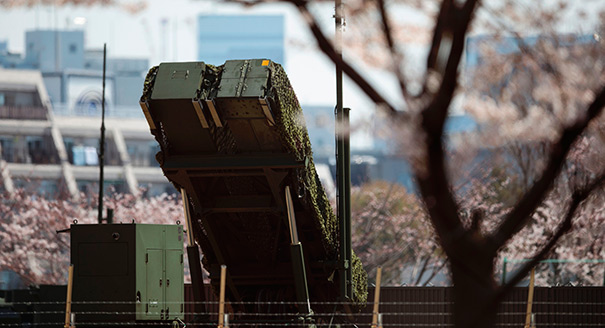As North Korea demonstrates new advances in missile technology and continues developing nuclear weapons, U.S. policymakers must ask themselves: Will Japan finally move toward acquiring offensive strike capabilities for the first time since World War II? Should Washington welcome such an effort?
Occasional surfacing of the so-called enemy base strike (teki kichi kōgeki) debate in Japanese political circles often produces alarmist headlines and predictions of a remilitarized Japan, but in fact this strike debate has been percolating for decades and is still rooted in Japan’s defensive military politics.
The following article and timeline explain the context and evolution of this strike capability discussion. It is an important defense policy initiative for the U.S.-Japan alliance to consider, even if it is less sensational than is frequently portrayed.
1. This Is Not a New Development
Japan’s debate over the constitutionality of enemy base strikes dates back to a 1956 statement made on behalf of then prime minister Ichirō Hatoyama. It said that striking enemy missile bases should be permissible within certain limits: Japan can take only the “minimum measures unavoidably necessary” when “no other measures” of self-defense are available in the face of an “imminent illegal invasion.” This statement became the bedrock of all future debates that sought to clarify Hatoyama’s interpretation, as part of a broader process to reconcile Japan’s exclusively defense-oriented policy (senshū bōei)—which prohibits the procurement of certain offensive weapon systems—with pressures caused by the continuing evolution of modern warfare. The strike debate began as a hypothetical exercise but became increasingly concrete from the late 1990s with a growing North Korea threat.
Three main components make up the strike debate: When exactly can Japan use force overseas for self-defense? How should “no other measures” be defined? How are strike capabilities for self-defense reconcilable with the general belief that Japan’s constitution prohibits offensive war-waging weapons? The historical timeline (see below) of statements by senior Japanese officials helps answer these questions.
2. Japan Can Only Constitutionally Strike an Enemy Base in Limited Circumstances
As alarm over Prime Minister Shinzo Abe’s 2006 base strike comments showed, many non-Japanese journalists continue to commonly mistake enemy base strikes as potentially “preemptive.”1 However, the record shows that Japanese officials have consistently rejected the concept of preemptive strikes (sensei kōgeki).2 Part of this confusion stems from the vagueness of language and translation, but some inconsistent remarks made by Japanese lawmakers have also contributed.
Japan’s term for preemptive strikes (literally translated as “head start attacks”) does not account for the subtle nuance in English forms of “preventive,” “preemptive,” or “first” strikes, though it is generally understood to mean attacking before a conflict erupts (as opposed to preemptively hitting a target after a conflict has already started). The earliest explanations provided by Japanese leaders were clear that “convenient” attacks for self-defense were not permissible and that only “the minimum measures unavoidably necessary” would be allowed. Later comments in 1999 and 2003 on the timing of strikes seemed to broaden this understanding, suggesting that Japan could strike enemy missile bases “at launch” or even before launch, if for example Japan observed North Korea erecting a missile on a launcher while verbally threatening Japan. But this theoretical hairsplitting about when an attack is under way soon receded in favor of more practical matters.
By 2009, the discourse had shifted more clearly toward only considering strikes against the enemy after Japan was hit by a missile, in order to stop subsequent barrages. North Korea’s introduction of road-mobile missiles and progress with solid-fuel technology makes “strike at launch” practically impossible in normal times. Moreover, Japan’s fielding of missile defenses from 2005 has provided it with more capacity to address initial missile threats without resorting to the early use of force. As a result, the term “counterattack” (hangeki) has become a more accurate description of what capabilities Japan might consider, and this was reflected in the most recent Liberal Democratic Party (LDP) study panel on the topic (in March 2017). In addition, Japanese defense white papers continue to rule out the constitutionality of weapons that cause “mass destruction” (kaimetsu-teki na hakai), such as long-range strategic bombers or attack aircraft carriers, so any future Japanese counterattack capability will be limited in scope and restricted in its use.
3. Regional and Domestic Dynamics Prompt These Recurring Debates
A frequent catalyst for recurring strike debates are major milestones in North Korean nuclear and missile testing. The first official ruling LDP study panel on strike capabilities directly followed North Korea’s Taepodong-1 missile test in 1998, while all subsequent LDP panels and spikes in Diet strike discussions have centered on later nuclear tests.3 As North Korea presses ahead with these programs, Japan’s counterattack capability discussions will likely intensify, especially now that Japan is developing its next five-year plan for defense procurement and revising its National Defense Program Guidelines.
Other factors, such as the policy leanings of government leadership, do play a role—the four LDP panels pushing strike debates in the Diet all occurred under the conservative Junichirō Koizumi and Abe administrations. In addition, some hedging against U.S. regional disengagement can be a factor. While Japan still clearly sees U.S. forces in the offensive role for their spear-and-shield defense relationship, in recent years Japanese officials have sought more comprehensive domestic capabilities as a way to strengthen deterrence independently and contribute more to the alliance so that Washington sees value in staying committed.
4. Japan’s Counterattack Capability Is a Long-Term Prospect
While North Korea’s missile progress since 2016 has put Japan further on edge and prompted a fourth LDP panel on strike capabilities, Prime Minister Abe’s weakened public approval in 2017 has made it hard for him to push aggressively for such a sensitive security policy change in the near term. The 2005 public outcry over the revelation of a secret 1994 strike study, as well as more recent protests on new security legislation in 2015 and related measures, is a reminder that the Japanese public has strong pacifist leanings and will oppose perceived overreach on this issue. Additionally, Abe will want to spend his dwindling political capital on his long-held goal of constitutional revision, and a bold move on strike would undermine this effort. Tight budget limitations and other pressing defense needs also work against major new investments in offensive systems.
Still, Abe and his team—including his new defense minister, Itsunori Onodera—think Japan should have some increased strike capacity, as do many in Japan’s foreign and defense ministries. The Abe administration has laid the rhetorical groundwork for such steps, highlighting North Korea’s military gains as a “new level of threat” (aratana dankai no kyōi) to Japan and the region. With the Ministry of Defense now preparing its five-year procurement plan and continuing discussions with U.S. officials on complementary roles, missions, and capabilities in the alliance, this is a good time for Japan to introduce modest policy steps for developing strike. The government is already studying issues related to equipping its new F-35 stealth fighter jets with air-to-surface missiles, and Japan is prioritizing new investments in intelligence, surveillance, and reconnaissance that would be necessary for supporting enemy base strikes. All of this suggests an emerging goal of developing limited counterattack capabilities, albeit incrementally and over the long term.
5. Japan’s Counterattack Capability Could Be Good for the United States
The United States should be receptive to Japan taking on a wider range of security roles, including adopting limited strike capabilities. It would contribute to more effective alliance interoperability and therefore enhance deterrence. It cannot be a substitute for U.S. offensive power in the region but can supplement U.S. forces if deterrence fails. At the same time, the allies need to coordinate closely with regional partners like South Korea to abate anxieties of remilitarization stemming from Japan’s colonial past. Given the fiscal and possible diplomatic costs, Washington should encourage Japan to consider measured investments in strike capabilities that can be deployed within the existing alliance framework and leave room for—and complement—other necessary defense acquisitions by Japan.
Notes
1 As described in more detail in the timeline, the supposed Abe quote supporting first strikes on enemy bases is actually a misattribution by non-Japanese newspapers—though Abe did discuss his hopes for a formal study on base strikes generally.
2 See former defense head Hosei Norota’s 1999 statement explicitly calling preemptive strikes unconstitutional and then prime minister Tarō Asō’s 2009 Diet statement differentiating preemptive strikes from enemy base strikes.
3 The main exception is the spike in strike discussions in 2015, due to deliberations on the 2015 Security Legislation (although this also took place amid a stepped-up pace of North Korean missile testing).
A Timeline of Japanese Leaders’ Statements on Offensive Strike Capabilities
Prepared by David Song and James L. Schoff
Foreign Minister Naka Funada, on behalf of Prime Minister Ichirō Hatoyama
The 1956 Hatoyama statement sets the foundation for future debate on enemy base strike capabilities, outlining the key constraints to any strike acquisition. As the first official government statement, it highlights three conditions for a constitutional strike: 1) there must be an “imminent illegal” attack on Japan, 2) all Japanese capabilities must be below the threshold of “minimum measures unavoidably necessary” for protection, and 3) strikes are only permitted if “no other measures are available” to defend Japan.
See the quoteJapan Defense Agency (JDA) Director General Shigejiro Ino
Ino parses the Hatoyama statement from the Japanese constitution’s restrictions against possessing weapons that can “offensively threaten” neighboring countries. Rather than directly address how base strike capabilities can avoid being offensively threatening, Ino instead argues that it is an improbable hypothetical scenario for Japan to have no assistance from the UN, the U.S.-Japan alliance, or other forms of external help when under attack—thus relying on the “no other available measures” clause to avoid contradiction between contemporary constitutional interpretation and the Hatoyama statement.
See the quoteJapan Air Self-Defense Force (JASDF), Air Staff Office
In the midst of ballistic missile defense (BMD) discussions in 2005, the Sankei Shimbun published an article revealing that the JDA conducted an enemy base strike study in 1994 that was never disclosed to the public. The study simulated using F-4 fighters to carry out strikes against missile bases, but concluded that Japan alone does not possess the capabilities to reliably conduct successful strikes and that Japan must depend on the United States for such missions.
The revelation by Sankei Shimbun caused a minor uproar among the Japanese public, leading then JDA director general Yoshinori Ōno to hold a press conference clarifying both the constitutionality of base strikes and the current lack of Japanese capability to conduct such strikes. It also supported the general opinion of U.S.-Japan role-sharing, in which the United States is the offensive “spear,” backed by Japan’s “shield” role.
Without answering whether [we] have the capability to preemptively strike enemy bases, we expect the American military to strike foreign territories.”
「敵地先制攻撃の能力のあるなしについては答えず、外国領域への攻撃は米軍に期待する。」
Yoshinori Ōno, “Director Ōno press conference summary,” Japan Defense Agency, hosted on Internet Archive, published April 8, 2005, https://web.archive.org/web/20060919080127/http:/www.jda.go.jp:80/j/kisha/2005/04/08.htm;
Hearing before the Security Committee in the House of Representatives, 162nd Diet (2005) (statement by Yoshinori Ōno, to questions from Representative Sato Shigeki, April 15, 2005), http://kokkai.ndl.go.jp/SENTAKU/syugiin/162/0015/16204150015007a.html.
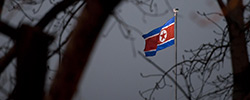
Milestone
August 31North Korea tests the Taepodong-1 medium-range ballistic missile for the first time (traversing over Japan into the Pacific Ocean).

Milestone
JanuaryThe Liberal Democratic Party (LDP) creates a crisis management project team, led by former Defense Agency chief Fukushiro Nukaga, to consider countermeasures for a possible second missile launch by North Korea. The team debates the possible role of Japanese offensive strike capability but does not recommend a policy change on that point.
Photo by Joe Jones
JDA Director General Takemasa Moriya
After North Korea’s 1998 Taepodong-1 test, the Diet renewed debate on enemy base strikes, with February discussions bringing a sharper focus on the limitations of such strike capabilities. In answering questions posed by opposition member Seiji Maehara on reconciling strike capabilities with Japan’s spirit of “nonaggression,” various speakers, including Moriya, reaffirmed that any base strike capabilities must be limited such that Japan cannot inflict “catastrophic” or devastating damage on any country. This reaffirmed Japan’s nonaggressive focus on self-defense in the face of new technological threats.
See the quoteJDA Director General Hosei Norota
At this pivotal moment after North Korea’s test, Norota seems to adjust the “imminent danger” clause of the 1956 statement by interpreting an “armed attack” against Japan as beginning at the moment when an aggressor nation “undertakes” (chyakushu) an attack. This might permit Japan to use force before receiving damage from an aggressor, although the “no other measures” limitation still applies. While he addresses the issue of striking enemy aircraft or warships in this quote, later in the Diet hearing he confirms that this interpretation of “imminent danger” also applies to enemy missile base strikes.
See the quoteJDA Director General Hosei Norota
In the context of the strike capabilities debate, Norota explicitly differentiates between preemptive attacks and enemy base strikes for self-defense, in order to emphasize the constitutional limitations of such capabilities.
See the quote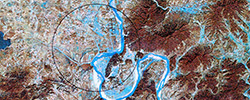
Milestone
January 11North Korea withdraws from the Nuclear Non-Proliferation Treaty, while resuming short-range missile testing in February and March.
JDA Director General Shigeru Ishiba
Building from Norota’s 1999 statements, Ishiba presents a hypothetical situation that could meet the conditions for a constitutionally legal act of self-defense vis-à-vis enemy base strikes. In the scenario, Ishiba argues that if North Korea raised a missile on a launch pad while declaring an intent to attack Tokyo, Japan could interpret the situation as North Korea having started to launch an attack—thus under the Hatoyama interpretation, Japan could strike North Korea’s missiles at-launch, before Japan received damage. Note that later, as North Korea continued to improve its missile technology, this hypothetical is quietly discarded in favor of a hypothetical where Japan counterattacks North Korea only after being struck by a first wave of missiles.
See the quoteIf North Korea both declares that it will turn Tokyo into ashes and raises a missile, I believe that counts as starting to launch [an attack]. I believe this situation can be understood under international law in this manner as well.”
「まさしく我が方が、つまり、北朝鮮が東京を灰じんに帰すというふうに宣言をし、ミサイルを屹立させたということに相なるとすれば、それは着手ということを考える。それが私は国際法上も理解できることだと思います。」
Representative Seiji Maehara
Maehara questions the contemporary “shield and spear” role division between the United States and Japan, earlier noting how despite the Hatoyama statement, Japan continues to be exclusively the shield in the relationship. Raising questions about trust in the U.S.-Japan relationship, Maehara introduces discussion on hedging on the relationship with the “minimum necessary defense capabilities” (saishōgen hitsuyō no bōeiryoku). In particular, he argues that with various new threats (cyber, missile, terror, and so on), the assumptions under the spear and shield system no longer hold, since the system was developed in the Cold War era to fight off land invasions and other outdated threats.
See the quote[But] in short, the spear and shield relationship now does not hold.”
[けれども]つまりは、盾と矛の関係というのは今成り立たないんですよ。」
Prime Minister Junichiro Koizumi
As prime minister, Koizumi reaffirms the existing government interpretation that enemy strike capabilities are compatible with Japan’s traditionally exclusive defense policy. In particular, he defends Ishiba’s answers on striking enemy missile bases “at-launch” as falling within the bounds of the Hatoyama statement.
See the quoteThe government has traditionally made public the opinion that, ‘In the event that an urgent, unjust invasion/violation is carried out against our country, and if this violation is an attack on our country’s soil through guided missiles, I cannot believe that it is the constitution’s intention for us to sit and wait for our own destruction. In such an event, I think that taking the unavoidably minimum measures in order to protect against such attacks—such as attacking missile bases in order to defend against missile attacks if no other measures are available—is legally within the scope of self-defense and should be considered a possibility.’ . . . And Defense Agency Director General Ishiba’s answer in the House of Representatives Budget Committee on January 24, 2003, repeats this traditional opinion. I do not think that this opinion . . . and the “nonaggressive defense policy” way of thinking contradict each other.
The aforementioned exclusive defense policy way of thinking captures the spirit of the constitution, and the government is not considering changing this.”
政府は、従来から、『わが国に対して急迫不正の侵害が行われ、その侵害の手段としてわが国土に対し、誘導弾等による攻撃が行われた場合、座して自滅を待つべしというのが憲法の趣旨とするところだというふうには、どうしても考えられないと思うのです。そういう場合には、そのような攻撃を防ぐのに万やむを得ない必要最小限度の措置をとること、たとえば誘導弾等による攻撃を防御するのに、他に手段がないと認められる限り、誘導弾等の基地をたたくことは、法理的には自衛の範囲に含まれ、可能であるというべきものと思います。』。。。との見解を明らかにしてきており、石破防衛庁長官の平成十五年一月二十四日の衆議院予算委員会における答弁等は、このような従来の見解を繰り返し述べたものである。このような見解と。。。専守防衛の考え方とが、矛盾するとは考えていない。
「前記のように、専守防衛の考え方は憲法の精神にのっとったものであり、政府としては、これを変更することは考えていない。」
JDA Director General Shigeru Ishiba
In an English-language interview, Ishiba confirms that Japan has the constitutional right to attack missile sites at-launch, before Japan receives any damage. Still, this only addresses the “imminent illegal” attack on Japan condition and not the “no other measures” for defense or “minimum measures” for defense limitations. On this latter point, Ishiba claimed in 2005 that procuring Tomahawk cruise missiles “may remain within the confines of the minimum necessary force for self-defense” due to their targeting accuracy, and he revealed that the Cabinet Secretariat debated this issue back in 2003 before deciding against pursuing Tomahawk acquisition.
See the quoteNao Shimoyachi, “Japan Mulled Buying Cruise Missiles for Pre-emptive Self-Defense: Ishiba,” Japan Times, January 25, 2005, http://www.japantimes.co.jp/news/2005/01/25/national/japan-mulled-buying-cruise-missiles-for-pre-emptive-self-defense-ishiba/#.WYjiE02Wzct.
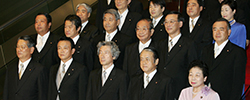
Milestone
OctoberPrime minister-selected panel recommends consideration for acquisition of strike capabilities.
JDA Director General Yoshinori Ōno
Ōno emphasizes that regardless of the introduction of ballistic missile defense (BMD) systems to Japan, the legal perspective on enemy base strikes does not change.
Ōno touches upon a key dichotomy between what he frames as the legal versus policy differences of enemy base strike capabilities. Beginning with how enemy base strikes have been interpreted as legal, Ōno also highlights the current Japanese policy showing offensive restraint as long as alternative means to addressing conflict exist, such as diplomacy, U.S. intervention, or BMD. Since Japan has always had alternative methods besides enemy base strikes even before BMD, the fundamental interpretation does not change: Japan can legally possess strike capabilities, though operationalizing such systems into policy is an entirely different matter.
See the quoteI can think of various means that can be considered ‘other measures.’ For example, I believe there is the issue of deciding which other measure to use, such as diplomatic responses, or the issue of role-sharing in the U.S.-Japan alliance system, or [official development assistance]. Among these other options, BMD has recently resulted from progress in science and technology—so how are we to continuing thinking about this matter? Based on this series of events, even up until now we have always had alternative means [from an enemy base strike]. How will we think of this?
I do not fully know whether policy and legal discourses have been confounded or not, in that [some argue] while the legal world permits a strike on enemy bases after a defensive launch order, Japanese policy argues that restraint should be shown in cases where there are other alternative measures. [I cannot confirm] whether Japan has always possessed alternatives [to base strikes, such as diplomacy, U.S.-Japan alliance, and so on], or whether the interpretation [on the constitutionality of striking bases] varies by case.
However, in any case, as I have written here, I think that the issue of a strike against enemy bases after a defense launch order legally does not change. In other words, regardless of the introduction of the BMD system, I believe there is no change in the legal way of thinking related to enemy base strikes, and it follows (and this is a fundamental point), through the appropriate role-sharing between the United States and Japan, Japan has no desire to possess enemy strike capabilities presently—that is what I want to clearly state.”
この他にかわる手段といえば、いろいろな手段があるかと思います。例えば、外交的な対応、あるいは日米安保体制のもとの役割分担の問題、あるいはODAをどうするか、こういうような問題もあろうかと思います。その中で、BMDというような最近の我が国の防衛については、科学技術の発達の結果でございまして、そのことをどう考えていくか。一連の流れの中で、今までにもそういう代替手段はあったわけでございます。それをどう考えていくか。
法理論の世界ではやはり防衛出動下令後に敵基地を攻撃することは許される、しかし、日本の政策として、他に代替手段がある場合には控えておくべきじゃないか、こういう政策論と法理論とが混同しているのかな、していないのかな、私はこの辺はよくわかりません。。。代替手段ということで考えれば、私は今までにもそういう意味での代替手段はあったのかな、場合によって解釈が変わってくる問題かなと。
「しかし、いずれにしましても、この防衛出動下令後の敵基地攻撃ということが、ここに書いてありますとおり、私は、法理的には変わらない。言いかえれば、BMDシステムの導入のいかんにかかわらず、敵基地攻撃に関する法理的な考え方には変更がないと思いますし、それから、基本的な問題でありますけれども、日米間の適切な役割分担を通じて、現時点で敵基地攻撃を目的とした装備を保有する気持ちは全くない、このことははっきりと申し上げたいと思います。」
Chief Cabinet Secretary Shinzo Abe
As part of a larger LDP-wide push for more concrete discussions on strike capabilities, then cabinet secretary Abe holds a press conference pushing for the LDP to hold an intra-party study on whether to acquire strike capabilities.
English and Korean language news outlets would later misattribute statements by Foreign Minister Tarō Asō and Fukushiro Nukaga to Abe, reinforcing neighboring nations’ suspicions of Abe’s agenda later when he became prime minister. On July 9, Asō states “if a nuclear-tipped missile approached Japan, there is no way that [Japan] will do nothing until it receives damage,” while Nukaga states “if it is important to defend our citizens, it is reasonable for us as an independent nation to possess limited strike capabilities.”
See the quoteIn relation to the constitution, to the extent that there are no other means to defend against a ballistic missile strike, attacking ballistic missile bases is constitutional and within the scope of the right to self-defense. . . . [But] should we have this capability? It is important that we deepen this discussion.”
「憲法との関係で、弾道弾などによる攻撃を防ぐために他に手段がないと認められる限りには、誘導弾等の基地をたたくことも法律上、自衛権の範囲内に含まれる … そういう能力を持つべきか。そういう中で議論を深めていく必要がある。」
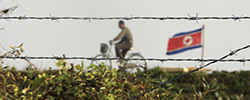
Milestone
October 9North Korea tests its first nuclear weapon.
Councillor Hisashi Tokunaga
While acknowledging its constitutionality, Councillor Tokunaga describes the technical obstacles that Japan faces in conducting an enemy base strike. In particular, Tokunaga highlights North Korea’s mobile launchers and underground tunnel systems as major barriers to effective strikes, in addition to Japan’s limited intelligence, surveillance, and reconnaissance (ISR) abilities. Tokunaga also argues that the difficulty of differentiating between a regular missile test and a missile aimed at Japan during the “at-launch” stage makes any at-launch enemy base strikes questionable.
See the quotePrime Minister Tarō Asō
Prime Minister Asō publically pushes for possibly including an official statement on enemy base strike capabilities in the National Defense Program Guidelines (NDPG) revision in 2009. A statement in the NDPG would have opened the doors for an official government study—beyond the intra-party study panels organized by the LDP—and would have been a major step forward for strike capability acquisition.
Asō emphasizes the difference between base strikes and preemptive attacks, while also falling back to the official government stance that Japan currently does not possess strike capabilities and must depend on the U.S.-Japan alliance, reaffirming the importance of the United States in Japan’s defense plans. Asō’s quote below hints at the challenge of the overall strike issue for Japan, as he urges further study.
See the quote[Citing the 1956 statement,] to stay in line with the oft-said, traditional statement, it is essential to differentiate [enemy base strikes] from preemptive strikes in situations when no armed attack is undertaken.
On the other hand . . . because [the Self-Defense Force, or SDF] does not possess force structure intended for enemy base strikes, in relation to this, my fundamental position is that we should preserve Japan’s peace and security by further strengthening the U.S.-Japan security system.”
「[これはずっと昭和三十一年から同じことであります。] 少なくとも、これが従来よく言われるように、武力攻撃を着手していない時点での先制攻撃とは違うというところが一番肝心なところであります。
「 他方。。。敵基地攻撃というものを目的とした装備体系。。。を保有をしておるわけではありませんので、こういったものに関しましては、日米安全保障体制を更にきちんとした上で、我々としては日本の平和と安全を期するということを基本として考えております。」
The LDP releases draft of its own NDPG
MayThe LDP explicitly supports initiating an official government study on strike capabilities in their proposed version of the NDPG. While acknowledging the importance of the United States’ offensive role in the U.S.-Japan alliance, the LDP draft discusses reevaluating this role-sharing, framing strike capabilities as a credible way to strengthen the allies’ and Japan’s own deterrence. Such language points to how hedging and increased independence act as two factors driving the LDP’s desire for strike capabilities.
See the quoteCurrently, while we depend on the United States for strike capabilities, it is necessary to reevaluate the appropriateness of this role-sharing in light of the present security environment and rearrange [it] through [the] guideline consultation. Above all, from the viewpoint of strengthening deterrence capabilities against the ‘missile threat,’ we should initiate a study and quickly reach a conclusion on our country’s possession of an independent strike capability (enemy base strike capability).”
「現在、打撃力については米国に依存している状態にあるが、このような役割 分担については、現在の安全保障環境に照らしてその適否を再検討し、ガイド ライン協議等を通じ整理する必要がある。 とりわけ「ミサイルの脅威」に対する抑止力を強化する観点から、わが国独 自の打撃力(策源地攻撃能力)の保持について検討を開始し、速やかに結論を 得る。」(pg. 8)
Officially released NDPG
DecemberIn contrast with the LDP draft, the official NDPG offers a vaguer recommendation, calling for a general study on ways to respond to the ballistic missile threat without specifying offensive strike. Arguably, the language of the NDPG also deemphasizes the elements of hedging and independent deterrence capabilities, focusing on the importance of the “appropriate” role-sharing between the United States and Japan. The LDP’s more pacifist ruling coalition partner, the New Kōmeitō party, had a role in modifying this language.
See the quoteDefense Minister Itsunori Onodera and Deputy Chief Cabinet Secretary Yoshiya Mutō
As Abe and the LDP discuss reinterpreting Article 9 of the Japanese constitution in 2014, various LDP officials seek to clarify that the official government position on enemy base strikes would not change. Drawing from the “three conditions” necessary for use of force under the original Article 9 interpretation, Onodera differentiates preemptive strikes from enemy base strikes by arguing that preemptive strikes fail to fulfill the first condition of “imminent illegal invasion”—wording that is built into the Hatoyama statement on enemy base strikes.
With a backdrop of the 2014 collective self-defense debates, Mutō argues that enemy base strikes fall solely under the provision of individual self-defense, and that no clear geographic limitations have been officially set due to lack of tangible discussion on operationalization. Such language both affirms the LDP’s push for an official study and acknowledges the uncertainties surrounding operationalizing strikes for real threats.
Because the first of the three conditions, of an ‘imminent illegal invasion,’ has been interpreted as when an armed attack has occurred on our country . . . if it means the use of force when there is no armed attack against our country, the first condition [for the right to self-defense] is not satisfied and the action would be interpreted as unconstitutional.”
この三要件の第一要件、我が国に対する急迫不正の侵害があることとは、我が国に対する武力攻撃が発生したことを意味するものと解されておりますので。。。我が国に対する武力攻撃が発生していない段階で我が国が武力の行使を行うことを意味するものであれば、この上述の要件を満たさず、憲法上許されないと解しております。」
In general, while the opinion has been expressed that it is not appropriate to geographically limit the activity locations of SDF that exercises individual or collective self-defense, there has been no such discussion on enemy base strikes or the aforementioned preemptive strikes with regard to the scope of individual self-defense.”
Prime Minister Shinzo Abe
With the NDPG revision coming into effect in 2014, Abe pushes for not only prioritizing improvements on BMD but also introducing an official government study on independent deterrence capabilities, implying enemy base strike capabilities as one of them. In response, several opposition members have cited the 1959 Ino statement on avoiding threatening neighbors, as well as a 1972 prime ministerial statement on “exclusive defense,” as the cornerstone of Japanese policy.
While the new NDPG did encourage a study for a “response capability” against missile threats, Bureau of Defense Policy Director Shuzo Tokudachi later responded in a May 22 Diet session that such an investigation did not necessarily mean base strike capabilities were the only explicit option on the table.
As for response capabilities against ballistic missile launch measures, in order to strengthen the entire U.S.-Japan alliance’s deterrence capabilities that are grounded on the appropriate U.S. role-sharing, it is an important step to conduct a study from the perspective of seeking to strengthen our country’s own deterrence and coping capabilities. Still, at the present time it is undecided whether to allocate funding next year for a study related to this topic.”
「弾道ミサイルの発射手段等に対する対応能力の在り方についても、日米間の適切な役割分担に基づき、日米同盟全体の抑止力の強化のため、我が国自身の抑止・対処能力の強化を図るよう、様々な観点から検討を行った上で、必要な措置を講じてまいります。なお、これに関する調査費を来年度に計上するか否かについては、現時点では未定であります。」
hearing before the Diplomatic Defense Committee in the House of Councillors, 186th Diet (2014) (statement by Bureau of Defense Policy Director Shuzo Tokudachi, May 22, 2014), http://kokkai.ndl.go.jp/SENTAKU/sangiin/186/0059/18605220059017a.html.
Defense Minister Gen Nakatani
Throughout the security legislation bill debates in the summer of 2015, various Japanese politicians raise the question of how aspects of the new bill concerning the new three conditions for self-defense would impact the strike capabilities debate. While the three new conditions allow for Japan to engage in collective self-defense, Minister Nakatani emphasizes that enemy base strike capabilities fall into the realm of individual self-defense. Other officials, such as Cabinet Legislative Bureau Director Yusuke Yokobatake, confirm on June 3 that even with the constitutionality of enemy base strikes, Japan cannot strike another country under the pretense of collective self-defense.
Additionally, in August 4 and August 24 Diet sessions, Nakatani and Yokobatake reject the notion that Japan has the capabilities to conduct enemy base strikes before an enemy damages Japan, instead emphasizing the prevention of “successive launches” at Japan vis-à-vis enemy base strikes. Thus, the strike debates in 2015 reinforce the official government interpretation expressed by Nakatani on August 26, which again emphasizes the nonpreemptive nature of a hypothetical base strike and the importance of the U.S.-Japan alliance to Japanese security.
hearing before the Special Committee on Japan and International Society’s Peace and Security Law in the House of Representatives, 189th Diet (2015) (statement by Cabinet Legislative Bureau Director Yusuke Yokobatake, July 3, 2015), http://kokkai.ndl.go.jp/SENTAKU/syugiin/189/0298/18907030298017a.html;
hearing before the Special Committee on Japan and International Society’s Peace and Security Law in the House of Councillors, 189th Diet (2015) (statement by Defense Minister Gen Nakatani, August 4, 2015), http://kokkai.ndl.go.jp/SENTAKU/sangiin/189/0192/18908040192007a.html; and
hearing before the Budgetary Committee in the House of Councillors, 189th Diet (2015) (statement by Cabinet Legislative Bureau Director Yusuke Yokobatake, August 24, 2015), http://kokkai.ndl.go.jp/SENTAKU/sangiin/189/0014/18908240014020a.html.

Milestone
September 9North Korea conducts its fifth nuclear weapons test.
LDP panel report on strike capabilities (panel led by Itsunori Onodera)
March 30The launch of the latest LDP panel on strike capabilities was reported shortly after North Korea’s fifth nuclear test in September 2016, with the public conclusions of the panel being released the following spring. While emphasizing the importance of the U.S.-Japan alliance, the findings also highlight the importance of enemy base strikes. The Japanese and English versions of the findings use the words “counterattack capability” (hangeki nōryoku), placing it in line with the recent emphasis on striking after Japan receives damage from a missile attack. Additionally, the report explicitly mentions cruise missiles as a possible option for strike capabilities. This appears to bear some promise as recent news reports on an official Japanese F-35 study mention possibly acquiring Tomahawk cruise missiles for enemy base strikes.
See the quote産経新聞「国内生産初号機公開のF35、敵基地攻撃能力の選択肢に」2017年6月5日, http://www.sankei.com/politics/news/170605/plt1706050038-n1.html.
